Quick Summary:
Do you want to develop the NFT Marketplace? But you’re unsure which NFT Business Model you want to go for? This blog will help you in making the right decision. In contrast to fungible tokens, like identical cryptocurrency units, non-fungible tokens (NFTs) are distinct assets. NFTs can be offered in a 1:1 ratio or multiples for the same good or experience. Due to the distinctiveness of NFTs and the unmatched advantages of blockchain technology it is possible to develop new NFT Business Models. Even if some possible NFT use cases are still difficult to envision, these NFT Business Ideas are finding their foot in the industry.
Compared to standard cryptocurrencies, non-fungible tokens are distinct. These digital tokens are incomparable because each one has a distinct online identity. Let’s further explain using an example from a popular cryptocurrency, such as bitcoin, Ethereum, Tether, or another. These may be traded for BTC at an equal price. NFTs operate differently, though. Digital assets are irreplaceable and cannot be copied, duplicated, or stolen. Because of smart contracts, it retains its intellectual property rights. But the asset’s novelty, location, and capacity for a single edition make it a superb digital asset in the crypto business.
A multimillion-dollar revenue structure is developing in the NFT sector. It makes sense that early adopters are already optimizing their income streams by utilizing the advantages of NFT across various sectors, including gaming, sports, entertainment, real estate, and more. The creation of the NFT platform, supported by Ethereum blockchain development services, offers unique characteristics and specialization for various tokenized solutions across sectors.
The NFT Business Model allows substantial investment opportunities and better results. NFT tokens are unique tokens made from collectibles or recognizable products like music, video games, artwork, and more. As a result of the NFT Marketplace Platform’s Development, users may tokenize their physical and digital assets and turn them into collectibles and tokens. The NFT Marketplace may function as a typical shop and auction platform.
To better understand NFT, let’s understand a few examples. Some of the best NFT examples include:
- Coupons/Ticket
- Digital collectible
- Domain
- In-game item
- Music Track
- NFT art app
- Original digital piece of art
- Patterns
- Unique pair of shoes
The Best Proof Of The NFT Marketplace Promising Future
-
- According to the Business Insider, the market for NFT reportedly reached $41 billion in 2021, almost equaling the absolute value of the global fine art marketplaces
- NBA’s best shots A trading card system is valued at more than $230 million
- In 2021, the Kings of Leon band sold their songs for $2,000,000
- The “most expensive” CryptoPunk NFT Sold for $532 million in October 2021
- Beeple’s first physical work was sold in November 2021 for over $30 million
- According to DappRadar, NFT Trading Volume Increased by 670% from Q2 2021
- The most expensive NFT meme was sold for $4 million featuring a picture of a Japanese hunting dog breed
- Thousands of NFT sales are made daily, with weekly sales ranging from $15,000 to $50,000
- BA’s Top Shots has already made more than $700 million off the sale of the card system
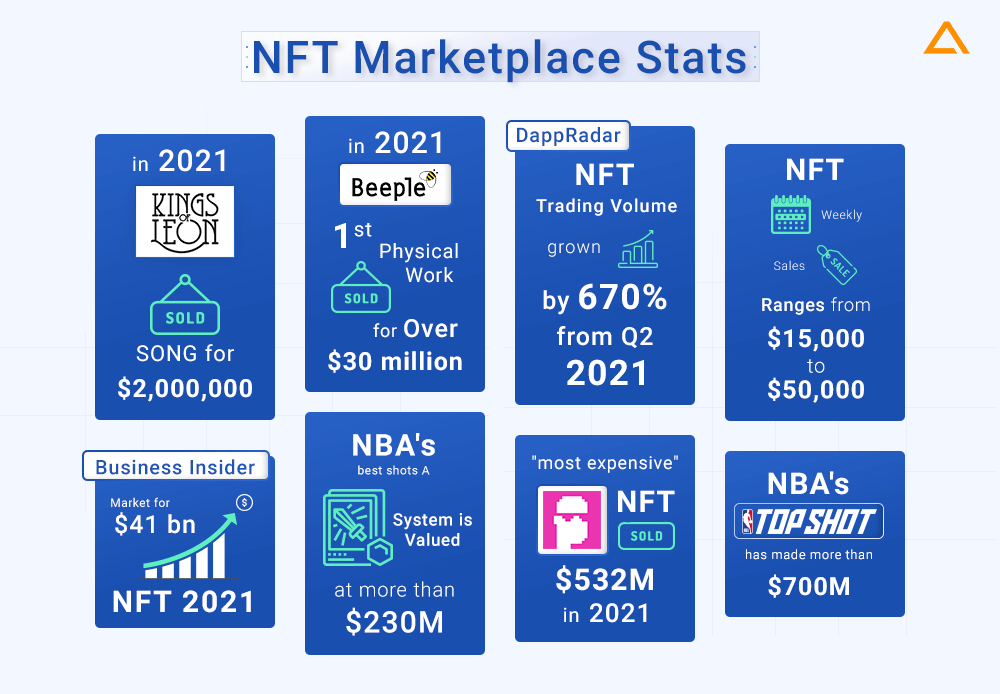
Now that we have an overview of the NFT marketplace let’s look at the NFT Business Ideas that are categorized into 4 Business Models.
NFT Business Model
To make the NFT Marketplace Business Model easier to grasp, it is broken into 4 segments. There is a sizable market for virtual products, making the NFT Business model an unquestionable choice.
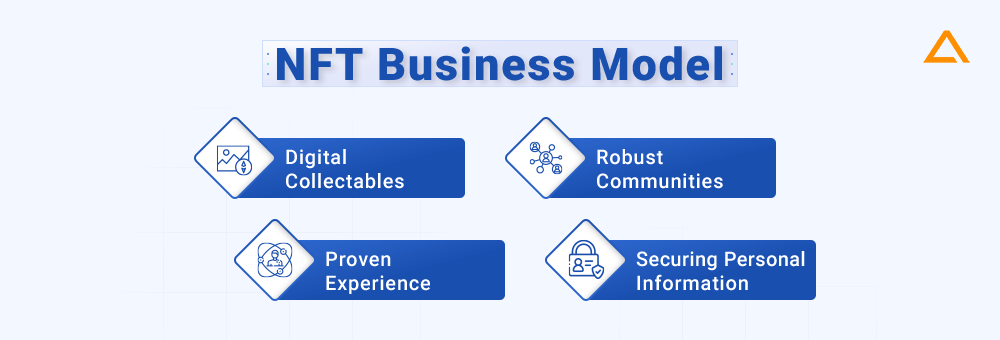
Digital Collectibles
Digital art most commonly addresses the NFT Business Model, which is also the most well-known. Along with music and clips from sporting events, digital collectibles often include other forms of intellectual property, such as patents. They want to show it to everybody. A digital asset allows you to display it to countless people while establishing your ownership without question. Using blockchain technology, NFT enables us to gather any digital object. Some NFTs can even act parallel with the natural object and serve as a digital twin. But how is it possible? While having a digital file that can be copied, emailed, downloaded, etc., may seem odd to some people. The Non-Fungible Tokens (NFTs) serve as distinctive identifiers of digital files that may be used to trace their history and demonstrate ownership. According to the guidelines outlined in a smart contract, the transactions are recorded in a decentralized database known as a blockchain.
This terminology might sound strange and foreign, but take a moment to consider how bitcoin works. NFT collectibles are similar to bitcoin because they are data storage units in a blockchain. Still, unlike bitcoin, which is fungible and interchangeable, NFTs are distinct and not interchangeable. This revelation has significant ramifications for digital assets that may now employ this technology for identification and traceability. NFT collectibles, like any other physical collection, can increase in value beyond economics depending on their scarcity, usefulness, and other considerations.
In the context of video games or the metaverse, collectible digital files are easily accessible through NFTs and may be gathered, exchanged, invested in, and even used for other purposes. Enormous consequences, as we’ve already stated. The rapid rise in popularity and adoption of NFTs is not surprising. Collectors, famous people, and significant businesses that dealt with natural treasures have not been the only ones to adopt the technology.
Robust Communities
NFT communities are associations of like-minded investors and collectors that work together to create their own culture and brand, advancing the project’s potential for future success. Projects involving NFT must have strong NFT communities to succeed. A specific blend of exclusivity and community is necessary for NFT initiatives to utilize social media to their fullest potential. Each owner of an NFT for a project is automatically a shareholder and a representative.
Some of the Popular NFT Communities include:
- Bored Ape Yacht Club
- CryptoPunks
- VeeFriends
- Cool Cats
- World of Women
- Deadfellaz
- Alien Frens
- CryptoMories
- Nuclear Nerds
- The Flower Girls

Most NFT communities start as NFT projects with 10,000 avatars, each with a distinct personality. Owning one of the community’s tokens is typically a requirement to become a legitimate member. As the group expands, it attempts to create a shared identity and culture that serves as a brand to the outside world. It’s challenging to compile a list everyone can agree on because everyone has their tastes. Despite this, it is our duty to prevent newcomers from becoming lost in the never-ending sea of NFT communities and initiatives. Many of the newer NFT initiatives are usually attractive to beginners with restricted budgets simply because they are less expensive.
There is nothing wrong with joining a smaller NFT community with a lower pricing point, but you should be aware that many con artists out there target new members. Before exploring a new area, we advise that you first join an established group and get some practice under your belt. This will significantly enhance your entire experience, and you could decide to remain with one of them in the end.
Also Read : NFT Marketplace Development Costs
Proven Experience
Paper records were used in the past to prove experience. This is still valid in many circumstances, such as when a college diploma or ticket is used. One of its many downsides is the ease with which paper paperwork may be misplaced or duplicated. NFTs may stand in for experiences like learning, seeing a concert, attending a sporting event, or traveling. This change in how we access and document experience might result in fewer institutions and ticket vendors because of blockchain’s intrinsic capacity to eliminate the middleman.
Some of these experiences may be virtual, reducing the actual area needed even further. The potential impact of NFTs on experiences is vastly oversimplified. Nevertheless, it’s intriguing to consider how this NFT technology can lower the middleman fees we pay for concert admission or share part of the earnings with players when a playoff series ticket is resold at a price higher than it was initially paid.
Securing Personal Information
The ability to secure and verify information on the blockchain makes an NFT solution worth considering for identifying documents and healthcare records. It is worth considering while storing sensitive personal information. Due to its security, you can also consider using the NFT solution for voting purposes
A massive variety of NFT use cases may be created using these four business models. In-game collectibles like a virtual Gucci bag that can be bought in Roblox for more than the actual handbag are examples of how gaming communities sometimes incorporate such items.
Checklist for NFT Marketplace Business Model
Typically, a checklist is made when planning a trip or packing for one. Similarly, this checklist will help create a successful NFT Marketplace Business Strategy:

Choose the Ideal Blockchain Network
The growth & popularity of the blockchain network can be seen through the stats provided above. In this digital era, cryptocurrencies are one of the most debated topics. Most of these cryptocurrencies are based on the blockchain network. Below are some of the Best Blockchain Networks on which NFT can be based:
- Azure Blockchain
- Corda
- EOS
- Ethereum
- Hyperledger
- Multichain
- NEO
- Solana
- Polkadot
- Polygon
- Stellar
- TRON
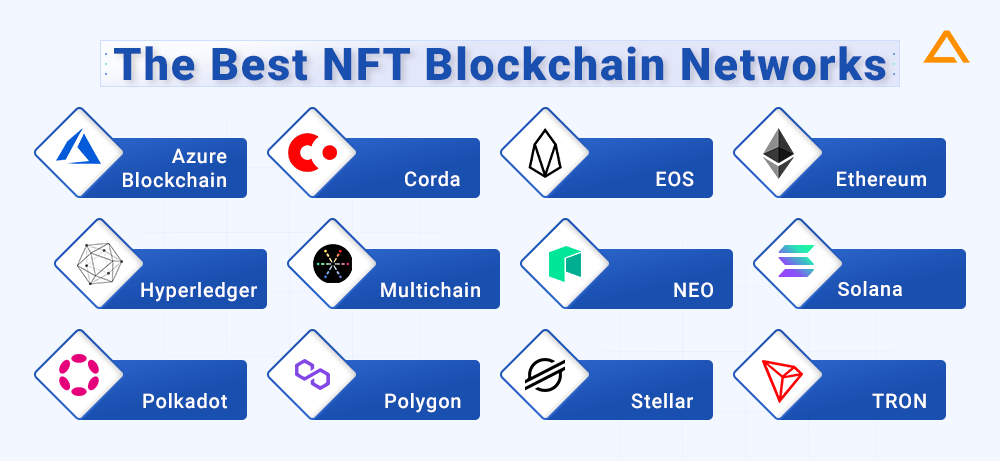
Having an overview of NFT can help you make an informed decision. You can also hire dedicated developers to develop the NFT solutions that suit your unique requirements and budget.
Select the Token Standard Accordingly
Selecting the token standards that best suit your company’s needs comes after choosing the blockchain network you wish to employ. You must use token standards like ERC-721 or ERC-115 since Ethereum, for instance, is the most talked-about blockchain standard. Similarly, given the NFT requirements, your token will be different.
ERC-721: In the NFT industry, ERC 721 is the most widely utilized token standard. Tokens created following ERC-721 specifications are all unique and immutable. The evolution of NFTs on the Ethereum blockchain is described in the standard.
ERC-998: The ERC-721 standard is expanded upon by ERC-998. It uses both uniform fungible tokens (ERC721) and distinct non-fungible tokens (ERC721) (ERC20). Consequently, a corporation intending to hold a group of assets opts for ERC 998.
ERC-1155: The token enables users to register fungible and non-fungible tokens by utilizing the same address and smart contract. The development of the coin took the NFT gaming platform into account.
TRC-721: On top of the TRON blockchain network, the token standard is based. On TRON, transactions may move and track NFTs via a standard interface. A knowledgeable and resourceful public chain structure makes it quicker and easier to deploy TRC-721.

In Search of Blockchain Development Company?
At Aglowid we can help you equip your business with secure, immutable & decentralized blockchain solutions.
Select your Domain
One of the most significant elements affecting the NFT market is the domain. To grab the attention of both buyers and creators, pick it intelligently. However, your business’s goal is the only factor that should influence the domain you choose. Select your serving niches first, then pick an intriguing domain name for this.
Some Popular Domain Names are listed below:
- Artworks
- Collectibles
- Domain Names
- Games
- Sports
- Metaverses
- Music
- Photographs
- Videos
- Trading cards
- Utility

These domains help enhance your brand’s presence in the NFT market since they rapidly attract users’ attention.
Select the Correct NFT Market Type
There are four types of NFT Marketplace. Open & Closed as well as Curated & Non-Curated. Both Open & closed marketplace works in the same way, but the only difference is that open NFT is accessible by any user type. Whereas, for a closed NFT Marketplace, only approved users are liable to participate in trades. Another one is curated and non-curated. In both curated and uncurated to promote and sell their works of art and valued projects, digital artists typically turn to specialize or niche sources. A piece of art may be sold online in a couple of minutes on non-curated NFT platforms, which are not curated by the company that built them. To use these services, users do not need to authenticate.
Also Read : Cost to Build an Online Marketplace
How to Monetize an NFT Marketplace Business Model?
NFTs are Etherium-based transactions for a digital asset. Utilizing blockchain technology, these coins are one-of-a-kind, verifiable, indivisible, and immutable. These NFTs represent ownership rights for digital assets, artwork, etc. The NFT Marketplace is where an NFT vendor offers their NFTs in return for a cryptocurrency. The Marketplace owner demands a fee from the NFT vendor, typically 2.5 to 5 percent. NFTs are sold and purchased by many people. Aside from this procedure, some charges and levies enable the owner of the NFT Marketplace to generate a respectable income as a commission.
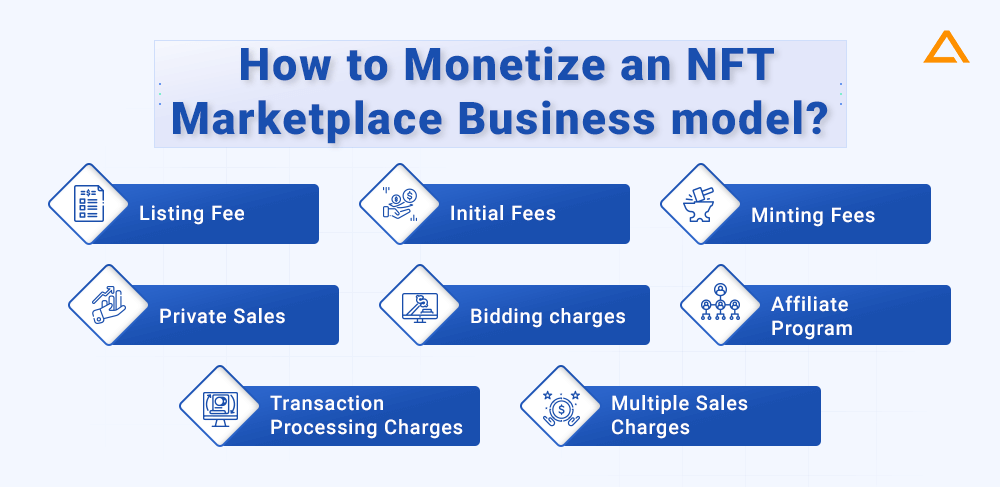
Listing Fee
The center for cryptocurrency memorabilia is NFT Marketplace. Over 2 million collections and over 80 million NFTs are present in OpenSea. Each collectible must be categorized separately, which is problematic. Because of this, grouping them into categories on a platform provides them a name under options that are simple to search. Businesses charge authors a fee for category listing since it is an easy process for NFT Marketplaces. You can determine the fees based on the cost, investor demand, freshly updated information, or other factors.
Initial Fees
Protocols support every NFT transaction, and NFT platform developers must pay for the technologies that enable NFT work. Businesses charge content producers early beginning fees to post on commercial websites to bridge the gap between technology and platform demands.
Minting Fees
Minting fees are assessed for registering original content or artwork on blockchain networks. Creating a blockchain-based NFT by “minting” a digital file is possible. Instead of minting each collectible one at a time, content providers may pay less by minting more of them on the platform.
Private Sales
The choice is offered only if the content author wishes to sell to a specific category. They have the option of paying the administrator for private sales fees. The rest can watch the merchandise and the sale or auction but cannot buy anything. Finding real clients rather than those who are merely looking to drive up the price of NFT is easier.
Bidding Charges
The NFT Business Model has the authority to impose extra fees in addition to the bidding cost. The creator or clients who wish to launch or participate in bidding must pay the sum. The date for the auction, the value of the products, and the entrance of players can all influence the bidding fees.
Transaction Processing Charges
To maintain and operate blockchain networks, gas costs(payments made by users to compensate for the computing energy) must be paid with the transaction processing fee. Curious as to why. Stablecoins, social tokens, and cryptocurrencies can all be used to make payments in peer-to-peer transactions. Blockchain technology is heavily employed in cryptocurrency, but investors must deal with it to complete transactions.
Affiliate Program
Every artist looks for a marketing plan for their products. Companies have the option to charge for supplying real-time information on bitcoin collectibles, rewards programs, auction notifications, and more.
Multiple Sales Charges
Implementing numerous sales tariffs is another way for NFT markets to make income. Artists frequently use the NFT Marketplace to post sales for various works. The Marketplace, however, must cover the network fees to execute these deals. From the creators, you can collect a percentage of this fee.
NFT Business Model: Wrapping Up!
So, this was it! Hope this article can help you make an informed decision about NFT Business Models that you can start with. With NFTs included in its robust ecosystem, the cryptocurrency economy has expanded even more. Several NFT Marketplaces might start operating in the future resulting Fashion designers, Artists, Photographers, Sports Enthusiasts, and game developers having access to the unique NFT Platform Business Model. As impact of this digital collectibles will become much more valuable.
have a unique app Idea?
Hire Certified Developers To Build Robust Feature, Rich App And Websites.
Also Check:
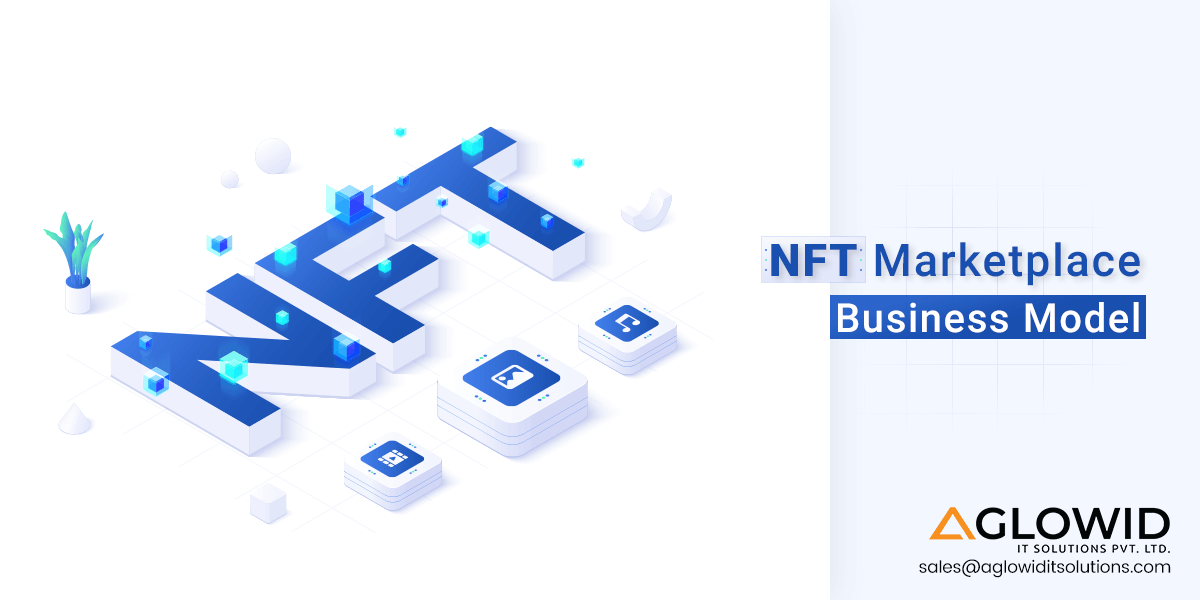

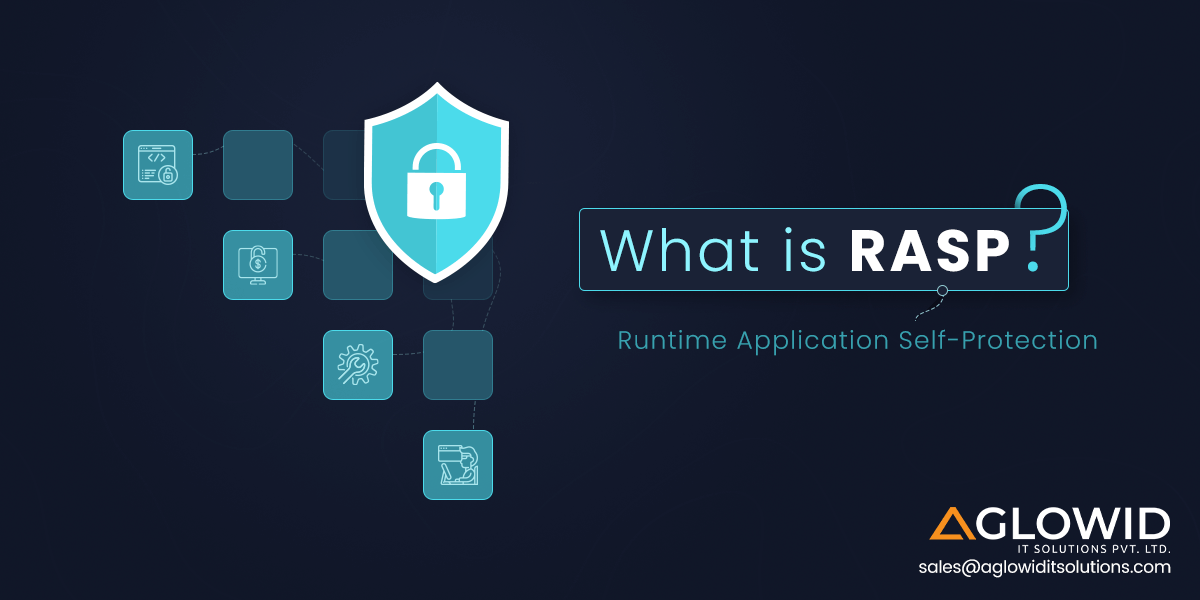


 Say
Say